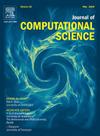Identification of ship motion model based on IPPSA-MTCN-MHSA
IF 3.1
3区 计算机科学
Q2 COMPUTER SCIENCE, INTERDISCIPLINARY APPLICATIONS
引用次数: 0
Abstract
An accurate ship motion model is crucial for predicting ship attitude, preventing accidents, and facilitating autonomous navigation systems. This paper treats ship motion modeling as a sequence modeling task and introduces a hybrid prediction model, termed MTCN-MHSA. The model integrates a Multi-Channel Temporal Convolutional Network (MTCN) and a Multi-Head Self-Attention Mechanism (MHSA). The MTCN, comprised of parallel TCN channels and a Bi-LSTM, extracts and fuses multi-dimensional features from the sequence. The MHSA mechanism is incorporated to minimize feature loss during information transmission, capture dependencies within the sequence, and enhance the model’s expressiveness and generalization capability. To optimize the hyperparameters of the MTCN-MHSA model, an Improved Positional PID-based Search Algorithm (IPPSA) is proposed, which builds upon the PID-based Search Algorithm (PSA). IPPSA exhibits superior global optimization capabilities and convergence speed, effectively identifying the optimal hyperparameters. Extensive comparative modeling experiments utilizing KVLCC2 and KCS ship maneuvering data validate the notable effectiveness and superiority of the proposed IPPSA-MTCN-MHSA model in ship motion prediction.
基于IPPSA-MTCN-MHSA的船舶运动模型识别
准确的船舶运动模型对于预测船舶姿态、预防事故和促进自主导航系统至关重要。本文将船舶运动建模视为一个序列建模任务,提出了一种混合预测模型MTCN-MHSA。该模型集成了多通道时间卷积网络(MTCN)和多头自注意机制(MHSA)。MTCN由并行TCN信道和Bi-LSTM组成,从序列中提取和融合多维特征。引入MHSA机制,最大限度地减少信息传输过程中的特征损失,捕获序列内的依赖关系,增强模型的表达能力和泛化能力。为了优化MTCN-MHSA模型的超参数,在基于pid的搜索算法(PSA)的基础上,提出了一种改进的基于位置pid的搜索算法(IPPSA)。IPPSA具有卓越的全局优化能力和收敛速度,能够有效地识别最优超参数。利用KVLCC2和KCS船舶机动数据进行的大量对比建模实验验证了所提出的IPPSA-MTCN-MHSA模型在船舶运动预测中的显著有效性和优越性。
本文章由计算机程序翻译,如有差异,请以英文原文为准。
求助全文
约1分钟内获得全文
求助全文
来源期刊

Journal of Computational Science
COMPUTER SCIENCE, INTERDISCIPLINARY APPLICATIONS-COMPUTER SCIENCE, THEORY & METHODS
CiteScore
5.50
自引率
3.00%
发文量
227
审稿时长
41 days
期刊介绍:
Computational Science is a rapidly growing multi- and interdisciplinary field that uses advanced computing and data analysis to understand and solve complex problems. It has reached a level of predictive capability that now firmly complements the traditional pillars of experimentation and theory.
The recent advances in experimental techniques such as detectors, on-line sensor networks and high-resolution imaging techniques, have opened up new windows into physical and biological processes at many levels of detail. The resulting data explosion allows for detailed data driven modeling and simulation.
This new discipline in science combines computational thinking, modern computational methods, devices and collateral technologies to address problems far beyond the scope of traditional numerical methods.
Computational science typically unifies three distinct elements:
• Modeling, Algorithms and Simulations (e.g. numerical and non-numerical, discrete and continuous);
• Software developed to solve science (e.g., biological, physical, and social), engineering, medicine, and humanities problems;
• Computer and information science that develops and optimizes the advanced system hardware, software, networking, and data management components (e.g. problem solving environments).
 求助内容:
求助内容: 应助结果提醒方式:
应助结果提醒方式:


